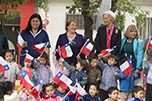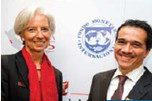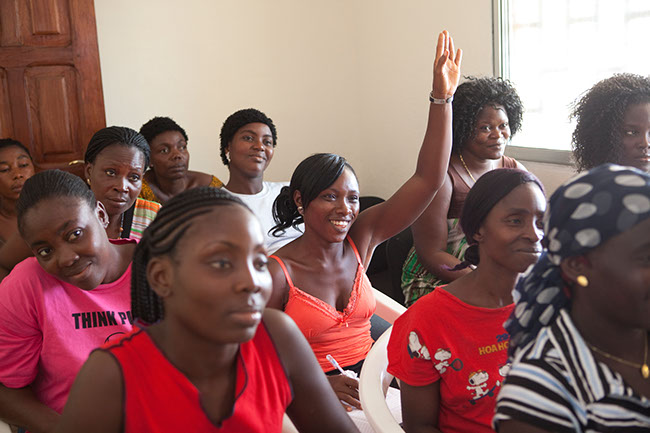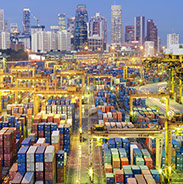Looking Back
This year has been crucial for reshaping the world’s development agenda. We also marked two important anniversaries—the 70th anniversary of the founding of the Bretton Woods institutions and 25 years since the fall of the Berlin Wall. This section looks at key events and trends shaping different parts of the world and the IMF’s work to support the membership in those areas, including activities leading up to the IMF–World Bank Annual Meetings in Peru.
Latin America

The Road to Lima: The 2015 IMF Annual Meetings
Peru: Staying the Course of Economic Success
Also in:Español
Latin America demonstrated remarkable vitality in the first part of the 21st century, experiencing strong growth and an economic renewal that gave new opportunities to millions of people. But the region now is facing serious challenges as growth slows. One crucial challenge is to put in place policies that ensure continued progress with inclusive growth in the context of a regional slowdown and changing global landscape.
This combination of progress and challenge will provide the setting for the October 2015 IMF–World Bank Annual Meetings in Lima, Peru. The meetings will highlight Latin America’s achievements over the past decade—particularly those of Peru, a country with its own success story to tell.
The Annual Meetings will be the first held in Latin America since 1967 in Rio de Janeiro, and only the second since 1952 in Mexico City. So for the IMF, Lima will represent an important stage in its relationship with the region. Some 13,000 people are expected to attend the meetings.
Slower growth for Latin America
Chile: What Does Prosperity Mean to You?
Also in:Español
The April 2015 Regional Economic Outlook (REO) for the Western Hemisphere projected that growth in Latin America and the Caribbean would decline for the fifth consecutive year, partly reflecting global developments but also the recent commodity price declines.
Growth has varied across the region, with South America and commodity exporters affected more than economies with closer ties to the United States or those that have a stronger growth potential. The REO highlighted a key priority for governments—raising investment, productivity, and potential growth. It identified improvements in business environments, infrastructure, and education as key to fostering more diversified, resilient, and inclusive economies. Another priority is to safeguard stability given the weaker growth and vulner-abilities among banks and corporations.
At a December 2014 high-level conference on “Challenges for Securing Growth and Shared Prosperity in Latin America,” held in Santiago, Chile, speakers highlighted the progress in achieving inclusive growth: the proportion of people living in poverty was 2.5 times greater than those in the middle class only a decade ago, whereas now they are about the same. Continued progress will be more difficult because of slow growth and weaker prospects.
Adjusting to a challenging global environment
The Santiago conference was an important stop on an agenda of events addressing the issues facing Latin America in the months leading up to the Peru Annual Meetings. This agenda—called the “Road to Lima”—is intended to broaden public under-standing of the challenges to achieving sustained growth, increased employment, and continued reductions in poverty and inequality. The Road to Lima also is intended to address the need to adjust to the challenging global economic environment.
-
 Stops on the Road to Lima
Stops on the Road to Lima
-

December 2014
Chile
Conference in Santiago on growth and prosperity in Latin America, followed by April 2015 regional outlook launch.

May 2015
Colombia
“Latin America: Challenges in a Rapidly Changing Global Environment,” a conference in Bogota

May 2015
Brazil
Visit of IMF Managing Director to Brasilia and Rio de Janeiro

June 2015
United States
High-level IMF Conference on Latin America “Rising Challenges to Growth and Stability in a Shifting Global Environment” in Washington, D.C.

June 2015
Peru
IMF–World Bank Conference on Financial Inclusion, in Lima

July 2015
El Salvador
13th IMF Central America Conference, in San Salvador

September 2015
St. Kitts & Nevis
Fifth IMF Caribbean Conference, in Frigate Bay

September 2015
Peru
Conference on “Managing Macroeconomic Success and Challenges,” in Lima
Promoting Growth in Latin America and the Caribbean
Last year, the IMF held two high-level conferences in Chile and Jamaica that focused on strategies to raise potential output and ensure sustainable growth. Over the past 15 years, most countries in Latin America and the Caribbean have become stronger, with significant advances in reducing poverty and inequality. Growth has, however, disappointed in recent years and created doubts about the continua-tion of economic and social gains. The two conferences discussed options to raise potential output, improve economic opportunities, lower energy costs, improve business environments, and expand financial inclusion. With demands of a growing middle class rising rapidly, experts also took a closer look at priorities in public spending and, in Latin America, the need for widening the tax base.

Key findings of the two events were:
- In the Caribbean, many countries are extremely dependent on imported oil for the generation of electricity and transportation. Efficiency gains can be achieved by closer cooperation between private and public sectors on generation and distribution of electricity and development of renewable energy sources. Governments, however, need to reform the regulatory framework to encourage private sector participation and also find new ways to address social inequalities without distorting pricing.
- Rules that are clear and consistent will help attract private investment. The array of tax incentives offered in many Caribbean countries has made the tax system increasingly complex and has eroded tax bases. Countries should reassess their taxation strategies to better meet competing goals of supporting growth and funding public services.
- In both the Caribbean and Latin America, broad access to financial services promotes growth and greater income equality. Both public and private sector involvement is needed to improve access. There is, however, a premium on safeguarding financial stability as instability has tremendous consequences for the poorest segments of the population.
- Finally, many economies in Latin America face resource constraints and a growing middle class that is frustrated with the lack of access to public services and economic opportunity. Participants in Chile discussed the need for deeper structural reforms to strengthen the availability and quality of public services, and improve educational outcomes.
- Achieving better outcomes requires more funding, which could be collected by broadening tax bases and bringing high-income groups into public systems of taxation and benefits.
- Work will also be needed to upgrade infrastructure and strengthen regional cooperation in traditional and less conventional areas like labor, security, energy, the environment, and competition.
A more comprehensive, strategic approach would help expand the provision of public services in emerging middle-income countries and raise potential output, thereby providing the foundation to permanently reduce poverty.
Africa

Harnessing Africa’s Demographic Dividend
Over the next 20 years, sub-Saharan Africa will become the main source of new entrants into the global workforce as infant mortality and fertility rates decline in the region.
By 2035, the number of sub-Saharan Africans joining the working-age population (ages 15–64) will exceed that from the rest of the world combined.
This is a trend with significant ramifications for both sub-Saharan Africa and the global economy.
This transition was part of a centerpiece analysis of the looming changes in sub-Saharan Africa’s labor force published in the April 2015 Regional Economic Outlook (REO) for sub-Saharan Africa. The study also describes a potential “demographic dividend” for sub-Saharan Africa, the magnitude of which will depend on how fast fertility rates decline and how strong the accompanying policies are. The region has been the second-fastest-growing in the world in recent years and has the potential to accrue economic benefits. The world economy also stands to benefit if sub-Saharan Africa’s labor force is integrated into global supply chains in an era of declining working-age populations elsewhere.
Financing for All: Promoting Financial Inclusion in Central Africa
Policy challenge: creating jobs
However, the policy chal-lenge is immense: sub-Sa-haran Africa needs to create high-productivity jobs at an extremely rapid rate for an extended period of time to absorb the growing labor force—about 18 million new jobs per year until 2035. While sub-Saharan Africa’s economic performance over the past 15 years—spurred, in part, by strong policies—gives reason for optimism that it can meet this challenge, a faltering performance could have dire consequences.
The REO analysis points to the need for policies that en-courage a gradual transition of labor to formal employment in nonagricultural jobs from the informal sector, which currently accounts for about 90 percent of the 400 million jobs in low-income sub-Saharan African countries. Investments in human capital—including health care and education — are critical in the early phases to accelerate the transition. While the region has made significant progress improving access to primary education, there is a need to improve access to secondary and tertiary schools, and to improve the overall quality of education.
Reform priorities in sub-Saharan Africa
The policy challenges to boost employment reflect the full range of sub-Saharan Africa’s reform priorities, including promoting private sector development, with emphasis on household enterprises; increasing agricultural productivity; and investing in infrastructure. Policies that facilitate the development of labor-intensive sectors that can compete globally are also necessary, as are policies that promote labor market flexibility. Furthering financial sector development to effectively channel savings into investment also can increase employment and growth.
Higher trade openness would also aid job creation, allowing sub-Saharan Africa to benefit from technology transfers and integration into global value chains. Expanding intra-regional trade and regional markets could boost incentives for domestic production, especially in labor-intensive manufacturing, and attract higher levels of investment.
Pan-African Banks: Opportunities and Challenges for Cross- Border Oversight
Africa Rising: Road to Mozambique
Also in:Français
Portuguese
As sub-Saharan Africa has emerged as the world’s second-fastest-growing region in recent years, economic integration has become an increasingly important driver of growth.
While trade and investment often receive the most attention, another key trend has been the emergence of pan-African banks.
The IMF African and Monetary and Capital Markets Departments cooperated during 2014 on a major research project that offered an in-depth look at the expansion of pan-African banking and the opportunities and challenges it represents. The research was presented to the Executive Board and later issued as a departmental paper. It also was summarized in the June 2014 issue of Finance & Development.
The pan-African financial institutions, which once largely did business in their home markets, now are creating cross-border networks and overtaking the European and U.S. banks that traditionally have dominated African banking. Along with spurring integration, they are giving impetus to financial deepening and inclusion, contributing to improved competition and innovation.
Pan-African banks originate mainly from the largest economies of Africa, such as Morocco, Nigeria, and South Africa, or from important countries within a region such as Kenya in the East African community. But an important pan-African institution, Ecobank, is headquartered in Togo; it was founded in the mid- 1980s with support from the 15-nation Economic Community of West African States. Although Ecobank is not the largest of the pan-African banks in asset size, it surpasses them all in terms of the geographical reach of its network.
The rapid expansion of pan-African banks poses oversight challenges that, if unaddressed, could potentially increase systemic risks.
These banking groups represent increased demands on home country regulators and supervisors to ensure that supervision of the banking groups based in their jurisdictions is done on a consolidated basis. Supervisory capacity is already constrained and under-resourced in most of Africa. The banking networks increase the importance of transparency and disclosure, good governance, strong prudential oversight, and a legal and regulatory framework that supports effective and comprehensive supervision and the need to prepare for crisis management. Progress is being made in most areas, but efforts to extend oversight to bank holding companies is needed in some cases.
Cooperation on cross-border supervision has started, but enhanced collaboration is critical.
Regional currency unions, such as the West African Monetary Union, face particular challenges on the interface of responsibilities between regional and national authorities. Pursuing the reform agenda expeditiously will require extensive technical assistance. The IMF is prepared to continue to provide assistance in its areas of responsibility and, if helpful, to liaise with other providers to help ensure a comprehensive program to safeguard financial stability.
Asia

China’s Rebalancing Act
Can Women Save Japan (and Asia Too?)
The 2014–15 slowdown in China—part of a broader trend in emerging markets—was felt throughout the global economy. The slower growth was part of a rebalancing effort undertaken by the Chinese government, and this shift became a focus of attention worldwide and an element of IMF risk assessment.
Analysis and policy advice across IMF members took the trend into account, particularly through the range of surveillance activities. This was fully reflected in the work of the Executive Board, whose discussions and public statements showed a keen awareness of China’s new direction.
China’s rapid growth—its economy is now the world’s largest in terms of purchasing power parity—has been a key driver of the world economy in recent years, particularly since the global financial crisis. Much of the current slowdown—growth declined to 7.4 percent in 2014 from 7.7 the year before and 10.2 percent in 2011—followed a generation of rapid expan-sion and reflected waning dividends from past reforms. But high levels of investment and credit growth created vulnerabilities.
A comprehensive blueprint of reforms announced at a high-level meeting of the Chinese Communist Party in 2013 heralded a shift in priorities toward higher levels of consumption, inclusive growth, and sustainable environmental policies.
IMF policy advice
(For Asia’s Quest for Inclusive Growth) Frontier Asia on the Rise
The reform agenda is broadly consistent with past IMF policy advice, including recommendations of the Executive Board. In its assessment of China’s 2014 Article IV consultation, the Board welcomed the reforms and said that the challenge “is to shift gears, reduce the vulnerabilities that have built up, and transition to a more sustainable growth path.”
The external implications of China’s slowdown were discussed in the April 2015 World Economic Outlook and Global Financial Stability Report, and were at the core of the 2014 Spillover Report, especially its discussion of intraregional spillovers. Regional Economic Outlooks also took China’s impact into account.
Article IV consultations of some other countries also have given considerable attention to the ramifications of China’s slower growth—in terms of both reduced trade and financial linkages. Risk Assessment Matrices in staff reports for countries across Asia included specific mention of the potential impact of the slowdown.
Executive Board Assessments of several Article IV reports discussed the Chinese slowdown in the context of other countries.
Impact on commodities markets
Commodities markets also have felt the effects of China’s slowdown.
Prices have fallen for many commodities, although this also reflects weaker global demand and new sources of supply.
It was not just oil, which fell more than 50 percent at one point in the past year. For example, sub-Saharan Africa faced sharp falls in the price of natural gas (45 percent), iron ore (34 percent), cotton (23 percent), copper (15 percent), and platinum (17 percent).
Despite the short-term impact globally, China’s leaders are committed to an economic path built around a more sustainable growth model. A comprehensive blueprint of reforms announced at a high-level meeting of the Chinese Communist Party in 2013 heralded a shift in priorities toward a more balanced and sustainable growth model, which would also be more inclusive and environment-friendly.
Middle East and Central Asia

Islamic Finance and the IMF
Four Things You Need to Know about Islamic Finance
Also in:عربي
Although still a small share of global financial markets, Islamic finance is growing rapidly. The banking segment of the market is increasing its presence in many IMF member countries, and it is becoming systemically important in some Asian and Middle East economies. Meanwhile, global issuance of Sukuk—the Islamic equivalent of bonds—is expanding to encompass a wide reach of issuers and investors.
Islamic finance—the subject of a Staff Discussion Note (SDN) issued in April 2015—has the potential to make important contributions in at least three areas. First, it promises to foster greater financial inclusion, especially of large, underserved Muslim populations. Second, its emphasis on asset-backed financing and risk-sharing means that it could support small and medium-sized enterprises, as well as infrastructure investment. Finally, its risk-sharing features and prohibition of speculation suggest that Islamic finance may, in principle, pose less systemic risk than conventional finance.
Regulation and supervision
The IMF long has taken an interest in the implications of Islamic finance for macroeconomic and financial stability, engaging member countries in the context of policy advice and capacity development, particularly in the areas of regulation and supervision, and development of domestic Sukuk markets. The IMF also played a key role in the establishment of the Islamic Financial Services Board, an international standard-setting organization that promotes and enhances the soundness and stability of the Islamic financial services industry by issuing global prudential standards and guiding principles for the industry.
The IMF took several steps in 2014–15 to broaden its understanding of Islamic finance and to foster wider understanding. In October 2014, an interdepartmental Working Group held its first meeting with an External Advisory Group that was established to help identify policy challenges facing the Islamic finance industry and to facilitate coordination with specialized and regional institutions, in terms of knowledge sharing, capacity development, and outreach.
Kuwait workshop
Building the Future: Jobs, Growth and Fairness in the Arab World
Also in:عربي
Français
In February 2015, the IMF hosted a regional workshop in Kuwait on “Risk-Based Supervision in Institutions Offering Islamic Services.” The workshop was attended by senior officials from banking supervision departments in Arab League countries and was organized by the IMF Middle East Center for Economics and Finance and the Middle East Regional Technical Assistance Center. The workshop provided guidance and training in the methodologies and approaches for implementing risk-based supervision in institutions offering Islamic financial services.
Several challenges need to be addressed if Islamic finance is to reach its potential. As outlined in the SDN, standards have been developed, but regulatory and supervisory frameworks in many jurisdictions do not yet cater to the unique risks of the industry. Regulators do not always have the capacity (or willingness) to ensure Shari’ah compliance, which undermines consistency of approaches within and across borders. A specific regulatory challenge relates to profit-sharing investment accounts at Islamic banks, which need to be treated in a manner consistent with financial stability. Moreover, although Islamic banks appear to be well-capitalized, the implementation of the Basel III Accord will present challenges. Finally, safety nets and resolution frameworks remain underdeveloped.
Assessing Concentration Risk of Banks in the Gulf
Important regional work takes place at the IMF outside of the context of the Article IV consultation process. One example was the staff paper on “Assessing Concentration Risks in GCC Banks,” pre-sented to the October 2014 Annual Meeting of Ministers of Finance and Central Bank Governors of the Gulf Cooperation Council (GCC).
The paper, prepared by staff from the Middle East and Central Asia Department and the Monetary and Capital Markets Department, addressed concentration risks—those involved in having too much money lent out to certain categories of borrowers—in the credit portfolios of banks in Bahrain, Kuwait, Oman, Qatar, Saudi Arabia, and the United Arab Emirates.
Well capitalized, but struggling to diversify credit portfolios
The paper found that banks in the GCC countries are generally well capitalized. However, because of the structure of their countries’ economies—with non-oil sectors dependent on developments in the oil sector—they struggle to diversify their credit portfolios and are consequently exposed to concentration risks that require a greater amount of scrutiny.
The analysis in the paper used credit risk modeling techniques to estimate the capital buffers required in light of the highlighted risks. The results suggest that the capital held by banks in the region is generally adequate to compensate for the concentration risks they face. Nonetheless, the paper recommended that a primary goal should be to ensure that existing strong capital buffers are maintained and that supervisors strengthen their capacity to monitor the buildup of concentration risk in banks’ portfolios.
How GCC banks can be strengthened
The paper also outlined areas for which bank regulation, supervision, and information disclosure in the GCC could be strengthened. Among the recommendations:
- Stress test exercises should be calibrated to fully capture the existing and evolving nature of interconnections and exposure concentration. Greater legal powers are required for regulators to collate information on the ultimate beneficial owners to better supervise banks’ risks derived from interconnectedness.
- To better monitor banks’ risks, GCC central banks should limit their exposures to a single borrower or closely related group of borrowers to a prudent maximum, in accordance with the new Basel guidelines, and also introduce aggregate limits on large exposures.
- Increased availability of data and further disclosures are needed for a better assess-ment of risks.
- This approach to financial sector analysis could be repeated across the IMF membership, with staff employing analytical tools to address the unique circumstances of banks, other financial institutions, and government bodies to give greater focus to financial stability.
Eastern and Central Europe

Looking Back on 25 Years of Historic Change in Europe
Europe marked an important anniversary in 2014: 25 years since the fall of the Berlin Wall and the beginning of a historic transformation in eastern and central Europe. The reintegration of the former communist countries into the global economy—and their entry into the IMF—in most cases brought major improvements in living standards.
The IMF European Department marked the anniversary with a Special Report, “25 Years of Transition: Post-Communist Europe and the IMF,” issued in October 2014. The paper summarized the stages of transition and looked at the challenges of the coming years.
The task of building market-oriented economies was difficult and protracted.
Liberalization of trade and prices came quickly, but institutional reforms often faced opposition from vested interests. The results of transition were uneven due to important differences in policy implementation. All countries suffered high inflation and major recessions as prices were freed and old economic linkages broke down.
By contrast, the early and mid-2000s saw uniformly strong growth. With macro–economic stability established and key market-based frameworks largely in place, the region experienced large capital inflows. This was supported by a benign global environment and increasing confidence in rapid convergence with western Europe—especially for the countries that joined the European Union (EU) during this period.
IMF Analyses Economic Transition of Western Balkan Countries
The increased participation of foreign banks—either directly or through subsidiaries and branches—in lending activity in central and eastern European countries brought much-needed credibility and technical know-how, and facilitated financing in the region—sometimes to excess, contributing to a rise in internal imbalances. The resulting vulnerabilities were exposed when the global and euro area crises struck at the end of the decade, hitting the transition economies hard.
In the wake of these crises, countries embarked on significant fiscal consolidation, although some continue to struggle to restore competitiveness and fiscal sustainability against the backdrop of a tepid global recovery and lingering structural weaknesses. Recent analysis shows the effect of widening disparities within the region: the more advanced countries, such as the Baltics and some central European countries, now have more in common with western European economies than they do with some former communist countries. But even in better-perform-ing economies, the pace of convergence toward EU levels of per capita income has slowed substantially. Moreover, reform momentum has generally decelerated over the years, with a risk of reversals emerging in a few countries.
To revitalize the convergence process and improve the resilience of the transition economies, a stronger commitment to market-based policies is needed. Two broad priorities stand out. First, there is a need for renewed focus on macroeconomic and financial stability in some countries. This could involve reining in persistent deficits and increasing debt, and addressing rising levels of bad loans in the banking system. Second, the pace and depth of structural reforms should be increased in areas such as the business and investment climate, access to credit, public expenditure prioritization and tax administration, and labor markets.
- Box 4.1: European New Member States Policy Forum
-
As Europe marked the 25th anniversary of the fall of the Berlin Wall, another important milestone was passed: the 10th anniversary of the accession to the European Union (EU) of the first group of countries from central and eastern Europe. To mark that event, the IMF held the first New Member States Policy Forum as a platform to discuss policy issues of common interest.
The forum brought together high-level representatives of six countries that are EU members, but not yet in the euro area—Bulgaria, Croatia, the Czech Republic, Hungary, Poland, and Romania. They were joined by the European Central Bank and the European Commission. The report on the forum—part of a series of IMF Cluster Consultations—was discussed with the IMF Executive Board in an informal session.
The forum report focused on four themes: euro adoption, opting into the banking union before euro adoption, the EU fiscal framework and pension reform, and making the most of the EU single market and EU Services Directive.
Baltic Cluster Report

One innovation growing out of the 2011 Triennial Surveillance Review has been the introduction of “cluster reports” to assess logical groupings of economies in an integrated fashion.
These assessments, which complement Article IV con-sultations with each member that makes up the clusters, are intended to strengthen the IMF’s work on interconnectedness—filling the gap between the assessments in Article IV consultations with members and multilateral surveillance of global economic trends.
The cluster reports assess spillovers across a group of interconnected countries by examining the risks from common shocks and highlighting shared policy challenges and, where relevant, the potential gains from policy coordination.
One of the pilots conducted during 2014 assessed the Baltic countries—the Republic of Estonia, the Republic of Latvia, and the Republic of Lithuania—in their trade and financial linkages to the Nordic countries. They also face common challenges.
In its assessment of the report, the Executive Board noted that while there is no articulated “Baltic Model,” all three countries have made impressive strides in advanc-ing income convergence with western Europe over the past two decades. Their policy approach has been based on generally prudent macro-economic policies, small governments, and a relatively favorable investment climate.
Directors underscored that the “creditless recoveries” in the Baltics could become increasingly difficult to sustain.
They commended the strong economic recovery from the global financial crisis, but noted that it had been accompanied by contracting credit to the private sector. While not an unusual pattern in a boom-bust cycle, continued anemic credit could constrain investment and growth.








